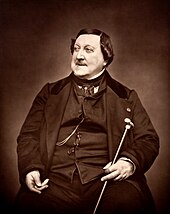
Petite Messe Solennelle seems a curious name for this large-scale choral work. Translating to mean ‘Little Solemn Mass’, this title is wrong on almost every count; it is not little (it fills an entire concert repertoire), it is certainly not solemn (it is almost dripping with boisterous frivolity), and it would seem most out of place if sung as part of a Latin Mass in Church. For what Petite Messe Solennelle fails to achieve with its title, it makes up for with its bombastic and ostentatious showcase of musical genius – namely that of Gioachino Rossini.

Rossini
Gioachino Rossini was born on the 29 February in 1792, and like so many of the great composers, he was born into a musical family. Having been trained rigorously in music – first by his parents, and later at a music school in Bologna – aged just 18, he composed his first opera which was later performed in Venice. This began 13 years of industrious opera writing, with no fewer than 34 operas for the Italian stage which were performed in Venice, Milan, Ferrara, Naples and elsewhere. It was in this period that he wrote perhaps his best-known work: Il barbiere di Siviglia (known in English as ‘The Barber of Seville’). By the age of 37 he had written over 40 operas, but, in 1829, after completing Guillaume Tell, he retired from writing opera, in ill health, but very wealthy.
In 1855 Rossini moved to Paris, and with this change came a newfound urge to compose. He wrote over 150 piano pieces, songs, and small ensembles, including Petite Messe Solennelle (1863). These works were only performed at his salon for private audiences (hence the titular ‘Petite’), which included most of the great artistic and public figures in Paris of the time. The private performances would have been a flamboyant marvel of drink, wit, and music, and it is no surprise that these compositions were referred to by Rossini as Péchés de Vieillesse (‘sins of old age’). Despite his lack of public compositional outlook and his withdrawal from the opera scene for over 40 years, he continued to be held in such enormous esteem that when he died in 1868, 6,000 mourners, four military bands, a chorus of 400 singers and several of the finest opera soloists of the day attended his funeral.

Petite Messe Solennelle
Rossini composed Petite Messe Solennelle in 1863, and it is dedicated to Count and Countess Pillet-Will. The work was first performed on 14 March 1864 at the couple’s new residence in Paris, with Albert Lavignac, who was aged eighteen, conducting from the harmonium. It was so popular that it was performed again the very next day.
Rossini knew full well that he was an opera composer at heart, and inscribed on his first edition: “Good God – behold completed this poor little Mass … O Lord, Thou knowest well, I was born for comic opera. A little science, a little heart, that is all. So bless Thee and grant me Paradise! G Rossini – Passy 1863”. Rossini is attributed to have also said “Give me a laundry list and I will set it to music.”, which only goes to show how Rossini’s inscription above is uncharacteristically earnest. As such, despite appearing to be a fulsome and flamboyant work, the opposite is true. Petite Messe Solennelle is not the flippant writing of a composer in his twilight, but rather a modest (petite) and sincere (solemn) work. Rossini, whose enormous wealth was due to his talents in the opera theatre, is ensuring that those same talents were used one last time as a final Gift to God – or perhaps even as conciliation for the mortal sin of writing comic opera.

Notes
Part 1
Petite Messe Solennelle is arranged in the same way as a liturgical mass, beginning with the Kyrie eleison. The music builds slowly, with long melodic lines underpinned by a driving and mechanical accompaniment. ‘Christe eleison’ interrupts in a polyphonic Renaissance style. The Kyrie then returns and modulates towards a major tonality.
The Gloria is assertive and delivered in a fanfare-like manner, before the soloists take centre stage with rising triplet sequences. A trio for alto, tenor and bass follows (Gratias agimus tibi) where Rossini shows his skill at using a simple melodic idea to create a rich contrapuntal sound. Domine Deus is a arguably the most operatic movement of the entire Mass, and it is not surprising that Rossini has given this heroic solo to a tenor. With huge leaps and sudden changes in tonality, Rossini certainly knew how to create drama. The soprano and contralto soloists seek the solemn mood in Qui tollis, hauntingly pleading for forgiveness. The bass aria, Quoniam, is declamatory yet also tender in style, building to a climax on the words ‘Jesus Christe’, exploring the entire bass register. The music of the opening to the Gloria returns and is extended for Cum sancto spiritu, with the addition of an upbeat fugal idea. We go through a journey of many different keys, melodic ideas and rhythmic drive in a bid to find a suitable end.
Part 2
Whilst the Credo begins in a typically brazen way, we quickly find a slightly more affectionate style, with solo passages passing around melodic ideas. The chorus only punctuates occasionally with ‘Credo!’ [I believe], before subduing on the words ‘In Unum Deum’ [In one God]. The movement ends with a jarring setting of the words ‘et homo factus est’ [and was made man]. Crucifixus is a lyrical soprano solo, portraying the sorrow at Jesus’ crucifixion in full operatic fashion. This section of the Mass concludes with another brilliant fugue for the chorus, on the words ‘Et vitam venturi saeculi, Amen.’
The Preludio is a welcome break for the singers, as an instrumental movement composed in fugal style. At this point in a liturgical mass, Bread and Wine would be offered to the Altar, and this movement sets a contemplative tone to reflect this.
The Sanctus and Benedictus are unaccompanied. The chorus and soloists here are in dialogue, starting quietly, but building to bursts of energetic dotted rhythms.
The O salutaris hostia is rather out of place, as it is not traditionally found in the liturgical mass. It is the first verse from a hymn of benediction, written by Thomas Aquinas for the Feast of Corpus Christi. This aria is most heartfelt and light.
The contralto solo aria for the Agnus Dei is virtuosic, with the full range being exploited. The chorus joins, singing ‘Dona nobis pacem’ [Grant us peace], with ever increasing intensity for a forceful chorus exit – although the piano and harmonium draws the mass to close in an unassuming and bizarre manner.
Samuel Foxon, 2022


Leave a Reply